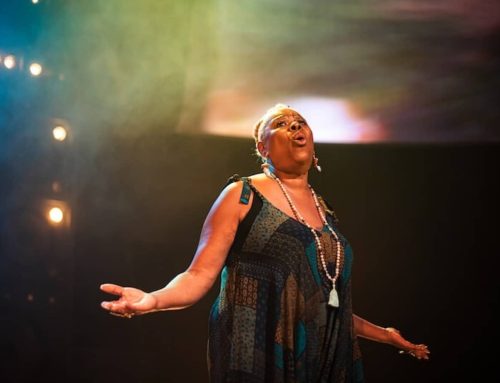G, Tife Kusoro’s dense, ambitious, multi-layered work about British black boyhood and urban surveillance won the 2023 George Devine Award, garnering high praise from that year’s judging panel. Drawing on a diverse range of motifs from Hollywood horror to afro-surrealism, to absurdism, to TV’s Stranger Things, the beautifully written piece oozes dreamlike ambiguity. Constant time and location shifts often make the piece difficult to follow, particularly for those unfamiliar with the urban slang that peppers Kusoro’s dialogue. But pitch-perfect performances, zippy direction from the ever more impressive Monique Touko, and Kloé Dean’s haunting choreography make this a riveting watch.
Year 11 classmates Joy (a striking turn by Kadiesha Belgrave), Khaleem (Ebenezer Gyau) and his half-brother Kai (Selorm Adonu) live in fear of urban myth Baitface the Gullyman (Dani Harris-Walters), a mystical white-clad figure who steals the faces, identities, and memories of black boys. Baitface died two decades previously after being falsely accused of a crime and has unfinished business to attend to. His uneasy soul now lurks in his bright white trainers which hang from a telephone wire. Walk under the wire without a balaclava, or worse touch the pristine Nikes, and you risk the full force of the ghoul’s maleficent attentions. Of course, one boy’s malignant spirit sometimes turns out to be another boy’s guardian angel.
Hollywood horror movie narratives depend on teenagers making really dumb decisions, a conceit Kusoro utilises in G. School head boy Kai, who boasts a sideline in selling his classmates dodgy homemade chicken wraps. The lad wants his mind expanded so decides to get stoned and deliberately summon up the spirit. “Not many people have been dumb enough to go under and get themselves cursed” warns Joy, who is on his own distinct journey of self-discovery and self-acceptance. Elder brother Khaleem, who has been held back in year 11 for unexplained reasons, later goes one further and removes the trainers entirely, intent on showing them off to his love interest Angel. Bad move.
Baitface “makes you forget everything” says Joy. But what exactly have the boys forgotten? TV news reports a search for three suspects accused on an unnamed crime on a recent evening. CCTV footage reveals boys wearing balaclavas and scuffling with each other. Police find a school homework diary at the supposed crime scene. But who does it belong to? Whoever owns the diary will face questions from the authorities.
Time, space, and identities are fluid and mutable in G’s complex narrative. Events shift between the night in question and weeks later. At one point Kai inhabits Khaleem’s body, “I can feel the chicken wings sliding down my guy’s throat” he tells us in awe. Doppelgangers of the boys, played by the same cast, exist inside the CCTV recording of the night in question, dreaming of events in real-life. Much of the dialogue in this alternative world makes no sense at all, which leaves Kloé Dean’s zombie-like robotic choreography to communicate story. One senses the dance moves may well draw consciously on the provocative iconography of UK drill music.
Harris-Walters’ scarily hunched Baitface gets no dialogue but paces through the auditorium during much of the action, occasionally fronting up to audience members. Gyau’s Khaleem feels immensely vulnerable, close to but never quite tipping over the edge. Adonu’s Kai is sparky and spiky, and a perfect counterpoint to Belgrave’s more contemplative Joy.
Throughout the piece the characters refer to each other as G. In the context of Jamaican music and culture, a Gullyman is often associated with toughness, street credibility, and resilience. One supposes Kusoro’s aim in G is to critique what she sees as the systemic oppression of young black boys that goes hand-in-hand with Britain’s all-pervasive CCTV culture. One hopes otherwise, but perhaps black boyhood is indeed cut short in a way that does not impact on white counterparts. More positively Kusoro’s ending offers up a message of hope: resilience and redemption, both the boys’ and Baitface’s, emerges from a strong, inclusive, loving community.
Madeleine Boyd’s clunky transverse set confuses rather than elucidates matters. CCTV recordings which contextualise the narrative are projected from ceiling to floor. It would work somewhere like the Dortfman, whose bear-pit like design facilitates great high-level sightlines. Seating banks upstairs at the Royal Court are pretty much on the same level as the stage, making it more or less impossible to see the projections. A minor gripe about a fascinating piece of work.
Writer: Tife Kusoro
Director: Monique Touko
More Recent Reviews
Playfight. Soho Theatre.
Writer Julia Grogan’s breathtakingly assured debut play arrives at Soho Theatre following stellar reviews at the Edinburgh Fringe and [...]
All The Happy Things. Soho Theatre.
Naomi Denny’s three-hander comedy-drama All The Happy Things covers familiar themes within a recognisable premise. A grieving protagonist comes [...]
Telly. Bread and Roses Theatre.
The challenge with absurdist comedy is that many people do not find it funny. Laughing at the sheer weirdness [...]






